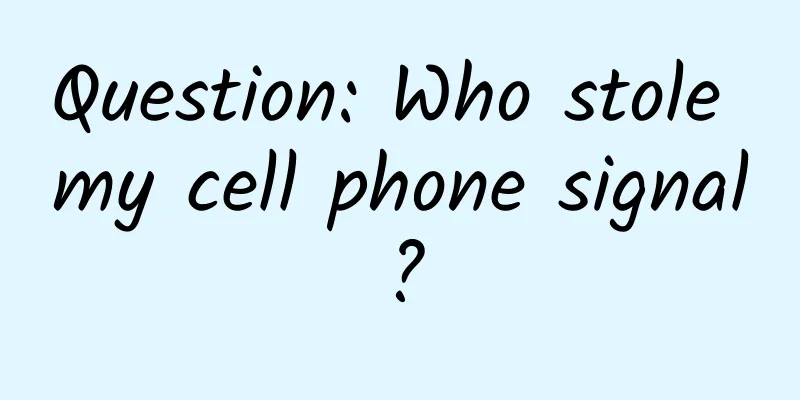Question: Who stole my cell phone signal?

|
As a communications engineer, I am often asked this question: Why is the mobile phone signal in my home so poor? Every time, I have to put in a lot of effort and give a lengthy explanation. As a result, before I finished explaining, the other party got impatient and replied directly: "It's just that XX (a certain operator) is too bad, I want to change my number." In fact, the problem of mobile phone signal is not as simple as everyone imagines. In order to eliminate everyone’s misunderstanding, today I will give you some knowledge about mobile phone signals. What is poor mobile phone signal? When it comes to poor mobile phone signals, the most intuitive feeling people have is usually that the Internet speed is slow, calls are intermittent, and the other party's voice is unclear. In fact, there is a reference benchmark for the quality of mobile phone signals. The first benchmark is the number of signal bars. When the number of signal bars displayed on the mobile phone is only one or two bars, people will judge that the mobile phone signal is poor. However, this method of judgment is not very accurate, because the number of mobile phone signal bars is not an accurate and consistent judgment standard. The number of signal bars of a mobile phone is not calculated according to a unified standard. It is defined by the mobile phone manufacturer itself and it is only related to the algorithm used by the mobile phone manufacturer. Therefore, the number of signal bars displayed by mobile phones of different brands in the same environment may not be the same. It cannot truly reflect the signal strength of your mobile phone. Fortunately, there is a way to find out your phone's true signal strength. For example, when an iPhone enters *3001#12345#* on the dialing screen and dials, the signal strength (in dBm) is displayed in the upper left corner of the screen. Android phones can check it through system settings, about phone, status messages, and signal strength. Android phones can also enter ?*#*#4636#*#* in the dial-up interface to view the number (I have personally tested this on Xiaomi phones). Pick up your phone and try it now, you will see a negative value followed by dBm. What does this number mean? Typically it ranges from -50 dBm to -120 dBm. -50 dBm means full signal, which means the signal is very good. If it is -120 dBm, your phone either has no signal or only one signal. The following two pictures are early comparison tests of the number of signal bars and the actual signal strength, for reference. From the above figure, we can see that the approximate corresponding relationship is as follows:
If you pay more attention, you will also see that the correspondence between the number of signal bars and signal strength is different for Android phones and iPhones. Even the correspondence between the number of signal bars and signal strength is different for different iOS versions of Apple. Okay, now you understand what poor signal means. Why is the signal poor at your home?
Among them, building obstruction is the biggest killer of mobile phone signals and the root cause of the poor mobile phone signal in your home. How severe is the obstruction of this building? That depends on the building structure and materials of your house. Now, let me list the nine killers that kill mobile phone signals. 9. Natural vegetation Signal attenuation: 3dB to 20 dB Okay, this isn't a building material, but there are always flowers and plants around your home. The heaviest foliage causes the signal to attenuate by about 7dB to 20dB. You might want to pay attention to this: if there are many trees around your home, the mobile phone signal will definitely be better in autumn than in summer. Why? The leaves are falling in autumn! 8. Transparent glass window Signal attenuation: 4dB In addition to blocking, reflection and refraction can cause the mobile phone signal to attenuate by 4dB. No. 7: Laminate/Plywood Signal attenuation: 4dB to 6dB It is worth mentioning that if the layer board is not waterproof, the signal can be attenuated by 20dB when it encounters moisture during the return of the south wind or water enters the board during rainy days. 6. Solid Wood Signal attenuation: 5dB to 12 dB Don’t be fooled by the appearance of solid wood furniture, it is a signal killer. Any type of wood, whether oak, mahogany, beech, maple, etc., will absorb and block cell phone signals. The thicker the wood, the worse the signal. 5. Mortar Signal attenuation: 8dB to 16 dB Commonly known as plastering, it is a building material made of lime or cement, applied to walls to protect them from erosion by wind, rain and snow. But who knew how much damage such a thin layer of paste would cause to the mobile phone signal? 4. Brick Signal attenuation: 8dB to 28 dB Bricks are a great building material invention, both in terms of architectural design and aesthetics. However, they are not friendly to mobile phone signals at all. 3rd place: Concrete and cement (15 cm thick) Signal attenuation: 10dB to 20 dB Most modern buildings are made of concrete, tall and solid, but then the cell phone signal says it can't stand it. Second place: Colored glass/low-e glass Signal attenuation: 24 to 40 dB The so-called low-emissivity glass is a glass surface coated with a metal film or metal oxide film containing one, two or even multiple layers of film system to reduce energy absorption or control indoor and outdoor energy exchange, ensure the comfort of life and work, and thereby achieve the purpose of environmental protection and energy saving. Some high-end office buildings use this material, and the signal attenuation is terrifying. *** Name: Metal Signal attenuation: 32dB to 50dB Metals such as aluminum, copper, steel, and iron are the biggest killers of mobile phone signals. So, if you have a metal shed on the roof of your house, it will be difficult for the mobile phone signal to reach it. In addition, metal objects in the house will also cause RF signal distortion. So, now it’s easy to explain why you have a bad cell phone signal at home. Assume that your mobile phone signal is full outdoors, and the displayed signal strength is -70dBm. Now, you walk into your home. Assuming that your home has red brick walls and redwood furniture, the mobile phone signal will be attenuated by at least 25dB:
This is why your cell phone signal is poor at home. This is also the reason why operators continue to build base stations and try to make them as close to your home as possible. Because the closer you are to the base station, the stronger the signal reaching outside your home, which in turn will slightly improve the signal strength reaching indoors. However, many residents do not understand this and believe that base stations will bring radiation and affect the health of themselves and their families. Even in many communities, there have been actions to resist the construction of base stations and even destroy them. ▲Residents of the community resist the construction of base stations ▲The base station that was forcibly destroyed In fact, this worry is completely unnecessary. The radiation from base stations is very small and will not cause any harm to the human body. The electromagnetic radiation from base stations will weaken as the transmission distance increases. People and mobile phones are in close contact, so the impact of mobile phone radiation on people is much greater than that of base stations. ▲Radiation comparison The radiation from base stations is even one thousandth of the radiation from sunlight, which is enough to show how weak the radiation from base stations is. Okay, that’s all for today. As mentioned earlier, mobile phone signals are not strong at all. They are fragile and sensitive and rely entirely on the day and night care of communications workers. So, when the signal at your home is bad, please be more understanding and patient. |
<<: Why have domestic mobile phones made a comeback?
>>: Research shows more than two dozen popular iOS apps send user data to third parties
Recommend
The legendary "Ice Tribe Divine Stone" in the web drama has been used by scientists to create a new world
Recently, the web drama "The Great Dream Ret...
US-South Korea auto trade deficit appears, Trump accuses South Korea of setting up barriers
According to foreign media reports, US President ...
Essential knowledge for APP mobile search promotion, practical introduction of Baidu Chunhua!
Baidu's APP promotion is mainly divided into ...
Why do you always want to jump down when you are standing on a high place?
This article was reviewed by Zhao Wei, MD, associ...
MultiChoiceAdapter—Easy to make ListView support multiple selections
introduce An adapter that provides multiple choic...
How to get big exposure through content at zero cost?
Marketing and promotion are always the pain point...
Useful Information | Learn Pinduoduo’s 5 high-conversion marketing strategies!
Pinduoduo, a new internet celebrity and a three-y...
Abdominal bloating, nausea, and regular abdominal pain, what is your stomach telling you?
Authors: Dai Qihua, Shanghai Jiao Tong University...
A bug making "ya ya ya" sounds, a toad with an "emoticon" face...how many creatures from the dinosaur era have you missed?
Dinosaurs lived from the Triassic period about 24...
Short video operation | What is the logic behind Kuaishou’s sales promotion?
Kuaishou Big Data Research Institute released the...
A set of pictures to understand Android, this foodie
If you have been to the Google headquarters in Mo...
Product operation strategy of Dianping Points Mall
Life service apps are closely related to users’ l...
iOS 8.3 makes some users unable to use Touch ID payment function
[[131544]] On April 10, according to foreign medi...
Well-known APP marketing director teaches you: How to plan an efficient marketing operation plan
What? Reading and understanding this article can ...
Get APP: Analysis of the operation and promotion strategies behind the development of knowledge service providers
This article takes product status, user growth an...









